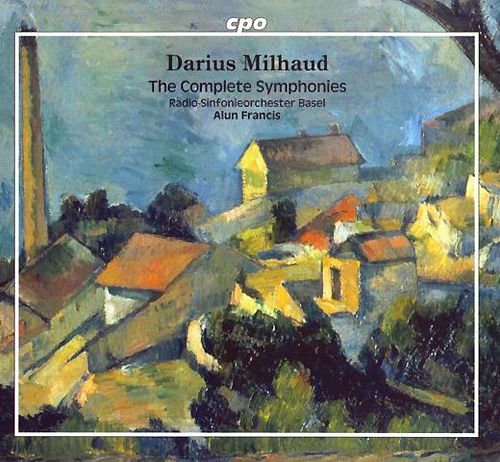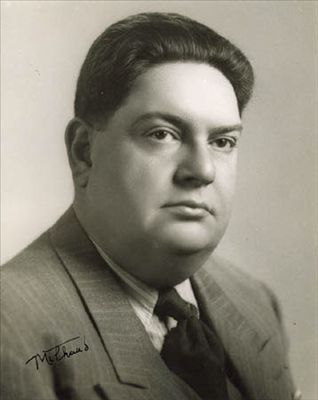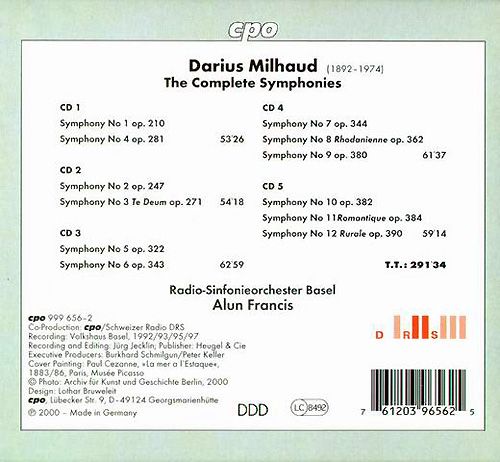wimpel69
03-18-2013, 12:00 PM
One of the more prolific composers of the twentieth century, Darius Milhaud (1892-1974) was born to a Jewish family
in southern France during the last decade of the nineteenth century. He learned the violin as a youth. Studies at the Paris
Conservatoire from age 17 on gave the young composer opportunity to work with some of the most prominent French
composers and theorists of the day, including Charles Marie Widor, Vincent d'Indy and Andr� Gedalge, and allowed him
to focus on developing his skills as a pianist.
While serving as an attach� at the French delegation in Rio de Janeiro during the First World War, Milhaud began a long
and fruitful association with poet Paul Claudel (who was at that time a Minister at the delegation), several of whose plays
Milhaud would go on to provide with incidental music (Prote�, 1919; L'annonce fait � Marie, 1934) and who, in turn, would
supply libretti for many of Milhaud's compositions (e.g. the opera Christophe Colomb of 1928).
After returning to Paris in 1919 Milhaud was adopted into the circle of "Les Six," a group of progressive French composers
brought together under the guidance of Jean Cocteau. However, like any such artificial collection, Les Six was quick to
dissolve, and during the 1920s Milhaud adopted an assortment of new musical influences (notably jazz, which the composer
first discovered during a trip to the U.S. in 1922, and which features prominently in much of his subsequent music).
Milhaud composed, performed, and taught ceaselessly during the 1920s and 1930s, only abandoning his homeland in late
1939 after all hope of resisting the German advance vanished. Settling in the United States, Milhaud accepted a teaching
position with Mills College in Oakland, California, and continued to compose prolifically. From 1947 he combined his American
teaching duties with a similar position at the Paris Conservatoire, remaining at both institutions until 1971, when his poor
health forced him into retirement (Milhaud had suffered from a serious, paralyzing rheumatic condition since the 1920s;
in later years he was only mobile through the use of a wheelchair). He died in Switzerland three years later.
Milhaud's musical output is impressive, both in terms of quantity and quality. The numbers alone are staggering for a
twentieth century composer: nine operas, 12 ballets, 12 symphonies (in addition to six chamber symphonies), six piano
concertos (one of them a double concerto), 18 string quartets, and about 400 other compositions in almost every
conceivable form and instrumentation. The most frequently discussed feature of his musical language is polytonality
(the simultaneous use of multiple tonal centers), though Milhaud was familiar with and fluent in any number of twentieth
century "techniques." A skillful contrapuntist, Milhaud composed two string quartets (Nos. 14 and 15, both from 1949)
which may also be performed simultaneously as an octet.

Music Composed by Darius Milhaud
Played by the Basel Radio Symphony Orchestra
Conducted by Alun Francis
"One forgets that Darius Milhaud was such a prolific composer (his catalog of compositions goes
out to 441 opus numbers) and that he wrote 12 symphonies. Outside of Camille Saint Saens and Albert
Roussel there have been few French composers who have been attracted to the symphonic form.
The symphonies or Darius Milhaud are characterized by their impressionism and dedication to the
traditional symphonic structure. Those written with three movements mimic the older sinfonia form of
Alessandro Scarlatti. Each work has an individual voice.
The First Symphony was written at the start of the Second World War and has an immediate appeal
with a strong pastoral melody that continues to develop and unfold during the movement. This is
followed by an engaging scherzo and a moody slow movement that seems to float along, as if describing
the sea. The final movement returns to the carefree mood of the first movement. The Fourth Symphony
commemorated the Revolution of 1848 and was written in the United States where Milhaud was living.
Each of the four movements describes an event: the insurrection, the dead of the Republic, the joys
of Liberty and Commemoration 1948. The Fourth is a very straightforward symphony whose depictions
are easy to understand and enjoy.
The Second Symphony was a commission from the Koussevitzky Foundation in 1944 and premiered in
Boston in 1946. Cast in 5 movements, the symphony slowly builds from the peaceful first movement
to the third movement (a kind of funeral march) with a fanfare played by the brass that shatters the
peaceful mood. The fourth movement returns to the quietly reflective mood of the first two and the
final movement is brilliant and exuberant. The Third Symphony was a departure for Milhaud -
a symphony with chorus. The symphony bears the title Te Deum and begins with a jubilant fanfare
followed by a remarkable second movement where the chorus sets the mood of the Te Deum singing
a wordless accompaniment. The third movement is an exuberant short orchestral movement and the
final movement brings in the chorus and orchestra in a glorious hymn of praise.
The Fifth Symphony was a commission from Italian Radio and is characteristic of Milhaud's linear
symphonic structure. Although the symphony was written during a period of musical experimentation
(in 1953) the music remains rooted in the French Impressionist style that makes Milhaud so
recognizable. The composer stuck to the four movement pattern for his symphonies. The Sixth
Symphony was written in 1955 for the 75th anniversary of the Boston Symphony. The Sixth differs
from the Fifth by being more expansive; slower tempi with more shading. The melodies are more
broken up than the more straightforward Fifth. Both symphonies contain marvelous melodies and
complement each other with their energy and pastoral beauty.
Symphonies 7, 8 and 9 stand as a group, all of them composed during the 1950's and music where
Milhaud gave more attention to the slow movements. This is apparent by looking at the timings
themselves but as one listens to them. In the Seventh, the slow movement is characterized by
choppy bit of melody from the orchestra over a grave melody played by the strings. The Eighth
symphony is a depiction of the Rhone River as it travels through France. One immediately notices
that the music is more astringent and the themes more broken. The slow movement sounds as if
portraying the river at early morning when shrouded by mist and everything is viewed in the soft
dawn light. The remaining movements are energetic and boisterous. The Ninth begins with a
whimsical theme that quickly develops into an energetic short movement. The slow movement
is ominous and melancholy but the mood breaks for the energetic final movement.
Symphonies 10 through 12 all date from the 1960's and all three had American commissions.
These late symphonies have been termed neoclassical. The Tenth was commissioned for the 100th
anniversary of the state of Oregon. It opens with the feel of a marching band in the use of
snare drums and quick tempi to be followed by a quiet and reflective slow movement. The final
movement is said to contain a theme based on the name Oregon. The Eleventh was commissioned
by the Dallas Symphony Orchestra and Public Library and has a long meditative middle movement
that has been interpreted as depicting the Dallas Public Library. The final movement is playful
and boisterous. The Twelfth and final symphony was commissioned by the University of California
at Davis. The symphony begins with a gentle pastoral theme that remains playful throughout
the movement. The second movement has a march-like theme followed by a reflective slow
movement. The final movement returns to the pastoral theme of the first movement and the
symphony ends with a flourish.
The recordings come from the 1990's and each disc is in its own jewel case. The recording balance
is superb and the Radio-Sinfonieorchester Basil, conducted by Alun Francis, play with real passion
and commitment. These are highly interesting symphonies that deserve to be heard more often.
Hopefully, this set will encourage their performance."
Amazon Reviewer


Source: CPO CDs (my rip!)
Format: mp3, 320k/s (CBR), DDD Stereo
File Size: 675 MB
Download Link: DepositFiles (http://dfiles.eu/files/zkc072lp7)
Please don't ask for lossless!
An expression of gratitude in this thread will get you a few bonus discs of Milhaud's music! ;)
Enjoy! Don't share! Buy the original! :)
in southern France during the last decade of the nineteenth century. He learned the violin as a youth. Studies at the Paris
Conservatoire from age 17 on gave the young composer opportunity to work with some of the most prominent French
composers and theorists of the day, including Charles Marie Widor, Vincent d'Indy and Andr� Gedalge, and allowed him
to focus on developing his skills as a pianist.
While serving as an attach� at the French delegation in Rio de Janeiro during the First World War, Milhaud began a long
and fruitful association with poet Paul Claudel (who was at that time a Minister at the delegation), several of whose plays
Milhaud would go on to provide with incidental music (Prote�, 1919; L'annonce fait � Marie, 1934) and who, in turn, would
supply libretti for many of Milhaud's compositions (e.g. the opera Christophe Colomb of 1928).
After returning to Paris in 1919 Milhaud was adopted into the circle of "Les Six," a group of progressive French composers
brought together under the guidance of Jean Cocteau. However, like any such artificial collection, Les Six was quick to
dissolve, and during the 1920s Milhaud adopted an assortment of new musical influences (notably jazz, which the composer
first discovered during a trip to the U.S. in 1922, and which features prominently in much of his subsequent music).
Milhaud composed, performed, and taught ceaselessly during the 1920s and 1930s, only abandoning his homeland in late
1939 after all hope of resisting the German advance vanished. Settling in the United States, Milhaud accepted a teaching
position with Mills College in Oakland, California, and continued to compose prolifically. From 1947 he combined his American
teaching duties with a similar position at the Paris Conservatoire, remaining at both institutions until 1971, when his poor
health forced him into retirement (Milhaud had suffered from a serious, paralyzing rheumatic condition since the 1920s;
in later years he was only mobile through the use of a wheelchair). He died in Switzerland three years later.
Milhaud's musical output is impressive, both in terms of quantity and quality. The numbers alone are staggering for a
twentieth century composer: nine operas, 12 ballets, 12 symphonies (in addition to six chamber symphonies), six piano
concertos (one of them a double concerto), 18 string quartets, and about 400 other compositions in almost every
conceivable form and instrumentation. The most frequently discussed feature of his musical language is polytonality
(the simultaneous use of multiple tonal centers), though Milhaud was familiar with and fluent in any number of twentieth
century "techniques." A skillful contrapuntist, Milhaud composed two string quartets (Nos. 14 and 15, both from 1949)
which may also be performed simultaneously as an octet.

Music Composed by Darius Milhaud
Played by the Basel Radio Symphony Orchestra
Conducted by Alun Francis
"One forgets that Darius Milhaud was such a prolific composer (his catalog of compositions goes
out to 441 opus numbers) and that he wrote 12 symphonies. Outside of Camille Saint Saens and Albert
Roussel there have been few French composers who have been attracted to the symphonic form.
The symphonies or Darius Milhaud are characterized by their impressionism and dedication to the
traditional symphonic structure. Those written with three movements mimic the older sinfonia form of
Alessandro Scarlatti. Each work has an individual voice.
The First Symphony was written at the start of the Second World War and has an immediate appeal
with a strong pastoral melody that continues to develop and unfold during the movement. This is
followed by an engaging scherzo and a moody slow movement that seems to float along, as if describing
the sea. The final movement returns to the carefree mood of the first movement. The Fourth Symphony
commemorated the Revolution of 1848 and was written in the United States where Milhaud was living.
Each of the four movements describes an event: the insurrection, the dead of the Republic, the joys
of Liberty and Commemoration 1948. The Fourth is a very straightforward symphony whose depictions
are easy to understand and enjoy.
The Second Symphony was a commission from the Koussevitzky Foundation in 1944 and premiered in
Boston in 1946. Cast in 5 movements, the symphony slowly builds from the peaceful first movement
to the third movement (a kind of funeral march) with a fanfare played by the brass that shatters the
peaceful mood. The fourth movement returns to the quietly reflective mood of the first two and the
final movement is brilliant and exuberant. The Third Symphony was a departure for Milhaud -
a symphony with chorus. The symphony bears the title Te Deum and begins with a jubilant fanfare
followed by a remarkable second movement where the chorus sets the mood of the Te Deum singing
a wordless accompaniment. The third movement is an exuberant short orchestral movement and the
final movement brings in the chorus and orchestra in a glorious hymn of praise.
The Fifth Symphony was a commission from Italian Radio and is characteristic of Milhaud's linear
symphonic structure. Although the symphony was written during a period of musical experimentation
(in 1953) the music remains rooted in the French Impressionist style that makes Milhaud so
recognizable. The composer stuck to the four movement pattern for his symphonies. The Sixth
Symphony was written in 1955 for the 75th anniversary of the Boston Symphony. The Sixth differs
from the Fifth by being more expansive; slower tempi with more shading. The melodies are more
broken up than the more straightforward Fifth. Both symphonies contain marvelous melodies and
complement each other with their energy and pastoral beauty.
Symphonies 7, 8 and 9 stand as a group, all of them composed during the 1950's and music where
Milhaud gave more attention to the slow movements. This is apparent by looking at the timings
themselves but as one listens to them. In the Seventh, the slow movement is characterized by
choppy bit of melody from the orchestra over a grave melody played by the strings. The Eighth
symphony is a depiction of the Rhone River as it travels through France. One immediately notices
that the music is more astringent and the themes more broken. The slow movement sounds as if
portraying the river at early morning when shrouded by mist and everything is viewed in the soft
dawn light. The remaining movements are energetic and boisterous. The Ninth begins with a
whimsical theme that quickly develops into an energetic short movement. The slow movement
is ominous and melancholy but the mood breaks for the energetic final movement.
Symphonies 10 through 12 all date from the 1960's and all three had American commissions.
These late symphonies have been termed neoclassical. The Tenth was commissioned for the 100th
anniversary of the state of Oregon. It opens with the feel of a marching band in the use of
snare drums and quick tempi to be followed by a quiet and reflective slow movement. The final
movement is said to contain a theme based on the name Oregon. The Eleventh was commissioned
by the Dallas Symphony Orchestra and Public Library and has a long meditative middle movement
that has been interpreted as depicting the Dallas Public Library. The final movement is playful
and boisterous. The Twelfth and final symphony was commissioned by the University of California
at Davis. The symphony begins with a gentle pastoral theme that remains playful throughout
the movement. The second movement has a march-like theme followed by a reflective slow
movement. The final movement returns to the pastoral theme of the first movement and the
symphony ends with a flourish.
The recordings come from the 1990's and each disc is in its own jewel case. The recording balance
is superb and the Radio-Sinfonieorchester Basil, conducted by Alun Francis, play with real passion
and commitment. These are highly interesting symphonies that deserve to be heard more often.
Hopefully, this set will encourage their performance."
Amazon Reviewer


Source: CPO CDs (my rip!)
Format: mp3, 320k/s (CBR), DDD Stereo
File Size: 675 MB
Download Link: DepositFiles (http://dfiles.eu/files/zkc072lp7)
Please don't ask for lossless!
An expression of gratitude in this thread will get you a few bonus discs of Milhaud's music! ;)
Enjoy! Don't share! Buy the original! :)